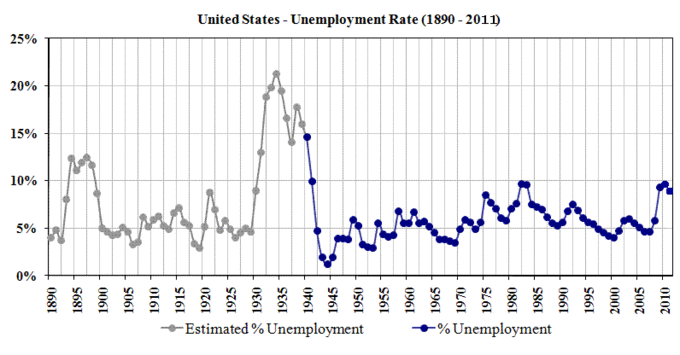There are four types of unemployment. The distinction between them is important to economists because the policy prescriptions for addressing each type vary.
Natural Level of Unemployment
The natural level of unemployment is the unemployment rate when an economy is operating at full capacity. This is the unemployment rate that occurs when production is at its long-run level, removing any temporary fluctuations and frictions. It is mainly determined by an economy's production possibilities and economic institutions. At this level of unemployment, the quantity of labor supplied equals the quantity of labor demanded, though this does not imply that unemployment is zero. The reason why the natural rate of unemployment is still positive is due to frictional and structural unemployment.
Frictional Unemployment
Frictional unemployment is the time period between jobs when a worker is searching for or transitioning from one job to another. It is sometimes called search unemployment and can be voluntary based on the circumstances of the unemployed individual. Frictional unemployment exists because both jobs and workers are heterogenous, and a mismatch can result between the characteristics of supply and demand. Such a mismatch can be related to skills, payment, work-time, location, seasonal industries, attitude, taste, and a multitude of other factors.
There is always at least some frictional unemployment in an economy, so the level of involuntary unemployment is properly the unemployment rate minus the rate of frictional unemployment.
Though economists accept that some frictional unemployment is okay because both potential workers and employers take some time to find the best employee-position match, too much frictional unemployment is undesirable. Governments will seek ways to reduce unnecessary frictional unemployment through multiple means including providing education, advice, training, and assistance such as daycare centers.
Structural Unemployment
Structural unemployment is a form of unemployment where, at a given wage, the quantity of labor supplied exceeds the quantity of labor demanded, because there is a fundamental mismatch between the number of people who want to work and the number of jobs that are available. The unemployed workers may lack the skills needed for the jobs, or they may not live in the part of the country or world where the jobs are available. It is generally considered to be one of the "permanent" types of unemployment, where improvement if possible, will only occur in the long run.
A common cause of structural unemployment is technological change. With the advent of telephones, for example, some telegraph operators were put out of work. Their inability to find work was due to an oversupply of skilled telegraph operators relative to the demand for workers with that ability.
Cyclical Unemployment
Of course, the economy may not be operating at its natural level of employment, so unemployment may be above or below its natural level. This is often attributed to the business cycle: the expansion and contraction of the economy around the long-term growth trend. During periods in the business cycle when the economy is producing below its long-run, optimum level, firms demand fewer workers and the result is cyclical unemployment. In this case the long-run demand for labor is higher than the temporary demand, so the rate of unemployment is higher than its natural rate .

U.S. Unemployment Rate
The short-term fluctuations in the graph are the result of cyclical unemployment that changes when economic activity is above or below its long-term potential. Over time, unemployment has returned to about 5%, which is the approximate natural rate of unemployment.